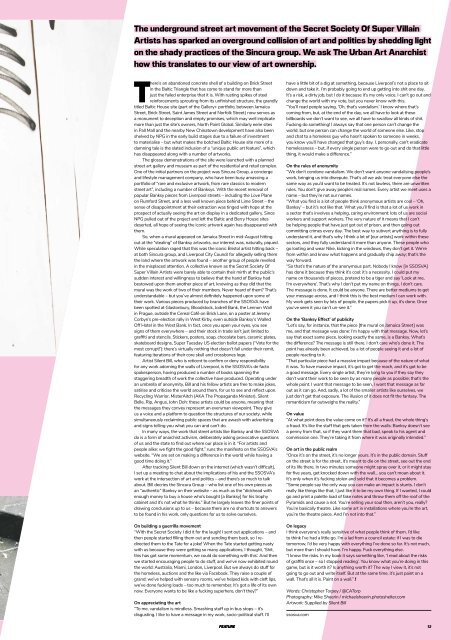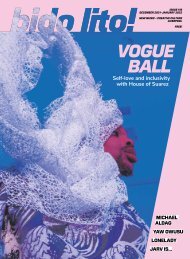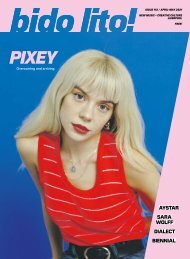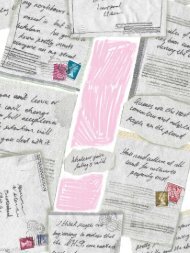Issue 83 / November 2017
November 2017 issue of Bido Lito! magazine. Featuring: SILENT BILL, SECRET SOCIETY OF SUPERVILLIAN ARTISTS, XAMVOLO, REMÉE, MERSEYRAIL SOUND STATION, HOWIE PAYNE, LOYLE CARNER, LIVERPOOL PSYCH FEST, ZOLA JESUS and much more.
November 2017 issue of Bido Lito! magazine. Featuring: SILENT BILL, SECRET SOCIETY OF SUPERVILLIAN ARTISTS, XAMVOLO, REMÉE, MERSEYRAIL SOUND STATION, HOWIE PAYNE, LOYLE CARNER, LIVERPOOL PSYCH FEST, ZOLA JESUS and much more.
Create successful ePaper yourself
Turn your PDF publications into a flip-book with our unique Google optimized e-Paper software.
The underground street art movement of the Secret Society Of Super Villain<br />
Artists has sparked an overground collision of art and politics by shedding light<br />
on the shady practices of the Sincura group. We ask The Urban Art Anarchist<br />
how this translates to our view of art ownership.<br />
There’s an abandoned concrete shell of a building on Brick Street<br />
in the Baltic Triangle that has come to stand for more than<br />
just the failed enterprise that it is. With rusting spikes of steel<br />
reinforcements sprouting from its unfinished structure, the grandly<br />
titled Baltic House site (part of the Gallery+ portfolio, between Jamaica<br />
Street, Brick Street, Saint James Street and Norfolk Street) now serves as<br />
a monument to deception and empty promises, which may well implicate<br />
more than just the site’s owners, North Point Global. Similarly eerie sites<br />
in Pall Mall and the nearby New Chinatown development have also been<br />
shelved by NPG in the early build stages due to a failure of investment<br />
to materialise – but what makes the botched Baltic House site more of a<br />
damning tale is the slated inclusion of a “unique public art feature”, which<br />
has disappeared along with a number of artworks.<br />
The glossy demonstrations of the site were launched with a planned<br />
street art gallery and museum as part of the residential and retail complex.<br />
One of the initial partners on the project was Sincura Group, a concierge<br />
and lifestyle management company, who have been busy amassing a<br />
portfolio of “rare and exclusive artwork, from rare classics to modern<br />
street art”, including a number of Banksys. With the recent removal of<br />
popular Banksy pieces from Liverpool streets – including the Love Plane<br />
on Rumford Street, and a less well known piece behind Lime Street – the<br />
sense of disappointment at their extraction was tinged with hope at the<br />
prospect of actually seeing the art on display in a dedicated gallery. Since<br />
NPG pulled out of the project and left the Baltic and Berry House sites<br />
deserted, all hope of seeing the iconic artwork again has disappeared with<br />
them.<br />
So, when a mural appeared on Jamaica Street in mid-August hitting<br />
out at the “stealing” of Banksy artworks, our interest was, naturally, piqued.<br />
While speculation raged that this was the iconic Bristol artist hitting back –<br />
at both Sincura group, and Liverpool City Council for allegedly selling them<br />
the land where the artwork was found – another group of people revelled<br />
in the misplaced attention. A collective known as the Secret Society Of<br />
Super Villain Artists were barely able to contain their mirth at the public’s<br />
sudden interest and willingness to believe that the hand of Banksy had<br />
bestowed upon them another piece of art, knowing as they did that the<br />
mural was the work of two of their members. Never heard of them? That’s<br />
understandable – but you’ve almost definitely happened upon some of<br />
their work. Various pieces produced by branches of the SSOSVA have<br />
been spotted at Glastonbury, Bloodstock, Jodrell Bank, the Lennon Wall<br />
in Prague, outside the Cereal Café on Brick Lane, on a poster at Jeremy<br />
Corbyn’s pre-election rally in West Kirby, even outside Banksy’s Walled<br />
Off Hotel in the West Bank. In fact, once you open your eyes, you see<br />
signs of them everywhere – and their stock in trade isn’t just limited to<br />
graffiti and stencils. Stickers, posters, soap, chocolate bars, ceramic plates,<br />
skateboard designs, Super Tuesday US election ballot papers (“Vote for the<br />
most corrupt!’): there’s virtually nothing that doesn’t fall under their remit,<br />
featuring iterations of their core skull and crossbones logo.<br />
Artist Silent Bill, who is reticent to confirm or deny responsibility<br />
for any work adorning the walls of Liverpool, is the SSOSVA’s de facto<br />
spokesperson, having produced a number of books spanning the<br />
staggering breadth of work the collective have produced. Operating under<br />
an umbrella of anonymity, Bill and his fellow artists are free to make jokes,<br />
satirise and criticise the world around them, for us to see and reflect upon.<br />
Recycling Warrior, MisterAitch (AKA The Propaganda Minister), Silent<br />
Belle, Rip, Angus, John Doh: these artists could be anyone, meaning that<br />
the messages they convey represent an everyman viewpoint. They give<br />
us a voice and a platform to question the structures of our society, while<br />
simultaneously reclaiming public spaces that are awash with advertising<br />
and signs telling you what you can and can’t do.<br />
In many ways, the work that street artists like Banksy and the SSOSVA<br />
do is a form of anarchist activism, deliberately asking provocative questions<br />
of us and the state to find out where our place is in it. “For artists and<br />
people alike: we fight the good fight,” runs the manifesto on the SSOSVA’s<br />
website. “We are set on making a difference in the world while having a<br />
good time doing it.”<br />
After tracking Silent Bill down on the internet (which wasn’t difficult),<br />
I set up a meeting to chat about the implications of his and the SSOSVA’s<br />
work at the intersection of art and politics – and there’s so much to talk<br />
about. Bill decries the Sincura Group – who list one of his own pieces as<br />
an “authentic” Banksy on their website – as much as the “dickhead with<br />
enough money to buy a house who’s bought [a Banksy] for his trophy<br />
cabinet and it’s not what he thinks.” But he largely leaves the finer points of<br />
drawing conclusions up to us – because there are no shortcuts to answers<br />
to be found in his work, only questions for us to solve ourselves.<br />
On building a guerrilla movement<br />
“With the Secret Society I did it for the laugh! I sent out applications – and<br />
then people started filling them out and sending them back, so I redirected<br />
them to the Tate for a joke! When the Tate started getting nasty<br />
with us because they were getting so many applications, I thought, ‘Shit,<br />
this has got some momentum, we could do something with this’. And then<br />
we started encouraging people to do stuff, and we’ve now exhibited round<br />
the world: Australia, Miami, London, Liverpool. But we always do stuff for<br />
the homeless, auctions and the like via Facebook. They raise a couple of<br />
grand; we’ve helped with sensory rooms, we’ve helped kids with cleft lips,<br />
we’ve done fucking loads – too much to remember. It’s got a life of its own<br />
now. Everyone wants to be like a fucking superhero, don’t they?”<br />
On appreciating the art<br />
“To me, vandalism is mindless. Smashing stuff up in bus stops – it’s<br />
disgusting. I like to have a message in my work, socio-political stuff. I’ll<br />
have a little bit of a dig at something, because Liverpool’s not a place to sit<br />
down and take it. I’m probably going to end up getting into shit one day.<br />
It’s a risk, a dirty job, but I do it because it’s my only voice. I can’t go out and<br />
change the world with my vote, but you never know with this.<br />
“You’ll read people saying, ‘Oh, that’s vandalism.’ I know where that’s<br />
coming from, but, at the end of the day, we all have to look at these<br />
billboards we don’t want to see, we all have to swallow all kinds of shit.<br />
Fucking do something! I always say that one person can’t change the<br />
world, but one person can change the world of someone else. Like, stop<br />
and chat to a homeless guy who hasn’t spoken to someone in weeks,<br />
you know you’ll have changed that guy’s day. I, personally, can’t eradicate<br />
homelessness – but, if every single person were to go out and do that little<br />
thing, it would make a difference.”<br />
On the rules of anonymity<br />
“We don’t condone vandalism. We don’t want anyone vandalising people’s<br />
work, bringing us into disrepute. That’s all we ask: treat everyone else the<br />
same way as you’d want to be treated. It’s not lawless, there are unwritten<br />
rules. You don’t give away people’s real names. Every artist we meet uses a<br />
name – but they’re not our names.<br />
“What you find is a lot of people think anonymous artists are cool – ‘Oh,<br />
Banksy’ – but it’s not like that. What you’ll find is that a lot of us work in<br />
a sector that’s involves a helping, caring environment: lots of us are social<br />
workers and support workers. The very nature of it means that I can’t<br />
be helping people that have just got out of prison, and then going out<br />
committing crimes every day. The best way to subvert anything is to fully<br />
understand it, and that’s why I think a lot of [our artists] work within these<br />
sectors, and they fully understand it more than anyone. These people who<br />
go looting and wear Nike, kicking in the windows, they don’t get it. We’re<br />
from within and know what happens and gradually chip away; that’s the<br />
way forward.<br />
“So that’s the nature of the anonymous part. Nobody I know [in SSOSVA]<br />
has done it because they think it’s cool: it’s a necessity. I could put my<br />
name on thousands of pieces, pretend to be a tiger and say ‘Look at me,<br />
I’m everywhere’. That’s why I don’t put my name on things, I don’t care.<br />
The message is done. It could be anyone. There are better mediums to get<br />
your message across, and I think this is the best medium I can work with.<br />
My work gets seen by lots of people, the papers pick it up, it’s done. Once<br />
you’ve seen it you can’t un-see it.”<br />
On the ‘Banksy Effect’ of publicity<br />
“Let’s say, for instance, that the piece [the mural on Jamaica Street] was<br />
me, and that message was done: I’m happy with that message. Now, let’s<br />
say that exact same piece, looking exactly the same, is a Banksy. What’s<br />
the difference? The message is still there. I don’t care who’s done it. The<br />
point has already been achieved, by a lot of people seeing it and a lot of<br />
people reacting to it.<br />
“That particular piece had a massive impact because of the nature of what<br />
it was. To have massive impact, it’s got to get the reach, and it’s got to be<br />
a good message. Every single artist, they’re lying to you if they say they<br />
don’t want their work to be seen by as many people as possible; that’s the<br />
whole point. I want that message to be seen, I want that message as far<br />
out as it can go. And, sadly, a lot of the smaller artists like ourselves, we<br />
just don’t get that exposure. The illusion of it does not fit the fantasy. The<br />
romanticism far outweighs the reality.”<br />
On value<br />
“At what point does the value come on it? It’s all a fraud, the whole thing’s<br />
a fraud. It’s like the stuff that gets taken from the walls: Banksy doesn’t see<br />
a penny from that, so if they want them that bad, speak to his agent and<br />
commission one. They’re taking it from where it was originally intended.”<br />
On art in the public realm<br />
“Once it’s on the street, it’s no longer yours. It’s in the public domain. Stuff<br />
on the street is for the street, it’s meant to die on the street, see out the end<br />
of its life there. In two minutes someone might spray over it, or it might stay<br />
for five years, get knocked down with the wall… you can’t moan about it.<br />
It’s only when it’s fucking stolen and sold that it becomes a problem.<br />
“Some people say the only way you can make an impact is stunts. I don’t<br />
really like things like that, I just like it to be my own thing. If I wanted, I could<br />
go and print a palette load of fake notes and throw them off the roof of the<br />
Pyramids and cause a riot. You’re selling your soul then, aren’t you, really?<br />
You’re basically theatre. Like some art in installations where you’re the art,<br />
you’re the theatre piece. And I’m not into that.”<br />
On legacy<br />
I think everyone’s really sensitive of what people think of them. I’d like<br />
to think I’ve had a little go. I’m a lad from a council estate: if I was to die<br />
tomorrow, I’d be very happy with everything I’ve done so far. It’s not much,<br />
but more than I should have. I’m happy. Fuck everything else.<br />
“I know the risks. In my book it says something like, ‘I read about the risks<br />
of graffiti once – so I stopped reading’. You know what you’re doing in this<br />
game, but is it worth it? Is anything worth it? The way I view it, it’s not<br />
going to go out and write itself. But at the same time, it’s just paint on a<br />
wall. That’s all it is. Paint on a wall.” !<br />
Words: Christopher Torpey / @CATorp<br />
Photography: Mike Sheerin / michaelsheerin.photoshelter.com<br />
Artwork: Supplied by Silent Bill<br />
ssosva.com<br />
FEATURE<br />
13


















